Multibody Dynamics for Assessing Tolerance Effects in Roller-Bearing-Supported Rings
Abstract
1. Introduction
2. Materials and Methods
2.1. Experimental Test
2.1.1. Experimental Setup
2.1.2. Inner Ring Reconstruction
2.2. Multibody Model
2.2.1. Geometry and Parameters
2.2.2. Boundary Conditions
2.2.3. Contact
2.3. Shape and Position Errors
- Δr(θ): error on the measure of the radius
- Δr0: average radial error
- Cn: amplitude of the n-th harmonic component
- n: order of the harmonic component
- φn: phase shift of the n-th harmonic function
- θ: angle position
- a.
- inner surface of the ring
- b.
- bearing shape
- c.
- bearings’ position
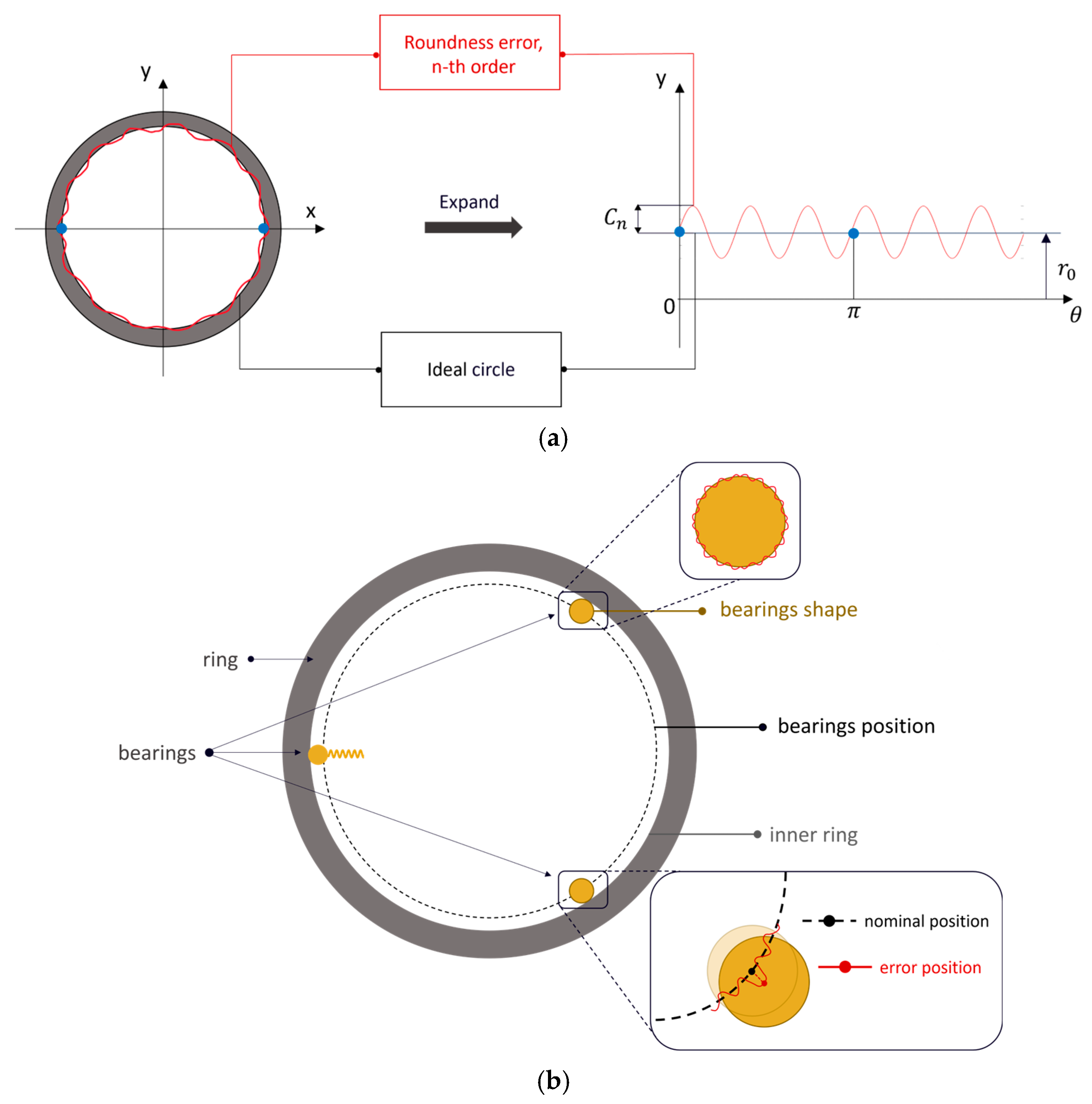
2.3.1. Shape Errors on the Inner Circumference of the Ring
Order of Shape Error in the Inner Circumference of the Ring
Amplitude of Shape Error in the Inner Circumference of the Ring
2.3.2. Error Combinations of the Ring Shape, Bearing Shape, and Bearing Position
| Group | Case | Ring Shape Error | Bearings Position Error | Bearings Shape Error |
|---|---|---|---|---|
| ring’s shape + bearings’ position | 1 | n = 2; r0 = 302 mm; Cn = 0.14; | n = 2; r0 = 297 mm; Cn = 0.14; | n = 0; r0 = 5 mm; Cn = 0; |
| 2 | n = 2; r0 = 302 mm; Cn = 0.14; | n = 7; r0 = 297 mm; Cn = 0.14; | n = 0; r0 = 5 mm; Cn = 0; | |
| 3 | n = 5; r0 = 302 mm; Cn = 0.14; | n = 5; r0 = 297 mm; Cn = 0.14; | n = 0; r0 = 5 mm; Cn = 0; | |
| ring’s shape + bearings’ shape | 4 | n = 2; r0 = 302 mm; Cn = 0.14; | n = 0; r0 = 297 mm; Cn = 0; | n = 2; r0 = 5 mm; Cn = 0.014; |
| 5 | n = 2; r0 = 302 mm; Cn = 0.14; | n = 0; r0 = 297 mm; Cn = 0; | n = 7; r0 = 5 mm; Cn = 0.014; | |
| 6 | n = 5; r0 = 302 mm; Cn = 0.14; | n = 0; r0 = 297 mm; Cn = 0; | n = 5; r0 = 5 mm; Cn = 0.014; | |
| ring’s shape + bearing position + bearing shape | 7 | n = 2; r0 = 302 mm; Cn = 0.14; | n = 2; r0 = 297 mm; Cn = 0.14; | n = 2; r0 = 5 mm; Cn = 0.014; |
| 8 | n = 2; r0 = 302 mm; Cn = 0.14; | n = 5; r0 = 297 mm; Cn = 0.14; | n = 7; r0 = 5 mm; Cn = 0.014; | |
| 9 | n = 3; r0 = 302 mm; Cn = 0.14; | n = 7; r0 = 297 mm; Cn = 0.14; | n = 15; r0 = 5 mm; Cn = 0.014; | |
| ring’s shape error | 10 | n = 2; r0 = 302 mm; Cn = 0.14; | n = 0; r0 = 297 mm; Cn = 0; | n = 0; r0 = 5 mm; Cn = 0; |
| 11 | n = 3; r0 = 302 mm; Cn = 0.14; | n = 0; r0 = 297 mm; Cn = 0; | n = 0; r0 = 5 mm; Cn = 0; | |
| 12 | n = 5; r0 = 302 mm; Cn = 0.14; | n = 0; r0 = 297 mm; Cn = 0; | n = 0; r0 = 5 mm; Cn = 0; |
2.4. Model Output
3. Results
3.1. Model Validation
- the profile error of the bearings is ignored
- the error of the bearings’ position is ignored
3.2. Shape Errors on the Inner Surface of the Ring
3.2.1. Influence of the Order of Roundness Error
3.2.2. Influence of the Amplitude of Roundness Error
3.3. Error Combinations
4. Discussion
- The most prominent simplification in the numerical model is the assumption that both the ring and the bearings behave as perfectly rigid bodies. The rigid-body assumption is justified for this system given the low speeds, relatively high stiffness of the ring and bearings, and the geometric scale of the tolerance-induced deviations. However, in high-speed, thin-walled, or ultra-precision applications, elastic deformation could significantly influence both static and dynamic responses and should be incorporated through compliant multibody or FEM-based modeling extensions.
- The present model targets low-speed operation (270°/s) with a fixed preload and rigid bodies coupled by penalty-based contact with normal and tangential compliances, viscous damping, and Coulomb friction with stiction and friction transitions. Lubrication, material hysteresis, and structural flexibility are not included. Jacobs et al. [31] experimentally show the formation of a lubricant film changes the stiffness and damping of a deep-groove ball bearing. Alfares et al. [32] show that the initial axial preload applied to the bearings plays a significant role in reducing the vibration levels. Following Jang & Jeong’s rigid-rotor formulation [33], the cage and ball-spin frequencies increase with speed via centrifugal and gyroscopic effects, so the principal order lines shift upward. Therefore, the here developed predictions should be interpreted as conservative for geometric-error-driven runout within the tested regime.
- The experimental ring is supported by physical bearings whose seating and alignment introduce subtle misalignments and damp high-frequency modes. The simulation, by contrast, assumes perfectly fixed vertical DOF of the ring and no assembly clearance.
- The reconstructed ring profile was assumed to be a perfect vertical extrusion between upper and lower cross-sections, whereas the real ring cut via waterjet may have slight axial taper or warping; the actual contact circumference between the bearings and the ring may present other shape errors that are not considered in this case. This approximation could magnify the lobing effect in the model compared to the smoother real contact behavior.
- Only the profile error of the inner ring surface was experimentally measured: in the actual model, there are several more tolerances to be examined, such as position error of the bearings, shape error of the bearings, diameter error, flatness, perpendicularity, etc.; being true that these have a smaller impact, their effect is not null. In particular, the exclusion of bearing position errors and housing misalignments may cause the model to over-predict sensitivity to the ring profile alone. Prior studies [24,27] emphasize that tolerance interactions are nonlinear, and overemphasis on a single tolerance source may inflate its simulated impact.
5. Conclusions
Supplementary Materials
Author Contributions
Funding
Institutional Review Board Statement
Informed Consent Statement
Data Availability Statement
Conflicts of Interest
Abbreviations
| CNC | Computer Numerical Control |
| CMM | Coordinate Measuring Machine |
| MBD | Multibody Dynamic |
| ISO | International Organization for Standardization |
| LT | Laser Triangulator |
| DOF | Degree Of Freedom |
| FEM | Finite Element Method |
References
- Slocum, A.H. Precision Machine Design; Society of Manufacturing Engineers: Southfield, MI, USA, 1992. [Google Scholar]
- Niemann, G.; Winter, H. Machine Elements Volume 2: Machine Components; Springer: Berlin/Heidelberg, Germany, 1989. [Google Scholar]
- Hou, Y.; Wang, X. Measurement of load distribution in a cylindrical roller bearing with an instrumented housing: Finite element validation and experimental study. Tribol. Int. 2021, 155, 106785. [Google Scholar] [CrossRef]
- Mikić, D.; Desnica, E.; Kiss, I.; Mikić, V. Reliability Analysis of Rolling Ball Bearings Considering the Bearing Radial Clearance and Operating Temperature. Adv. Eng. Lett. 2022, 1, 16–22. [Google Scholar] [CrossRef]
- Pastukhov, A.; Timashov, E.; Stanojević, D. Temperature Conditions and Diagnostics of Bearings. Appl. Eng. Lett. 2023, 8, 45–51. [Google Scholar] [CrossRef]
- Pastukhov, A.; Timashov, E. Procedure for Simulation of Stable Thermal Conductivity of Bearing Assemblies. Adv. Eng. Lett. 2023, 2, 58–63. [Google Scholar] [CrossRef]
- Noguchi, S.; Ono, K. Reduction of NRRO in ball bearings for HDD spindle motors. Precis. Eng. 2004, 28, 409–418. [Google Scholar] [CrossRef]
- Bhateja, C.P.; Pine, R.D. The rotational accuracy characteristics of the preloaded hollow roller bearing. J. Lubr. Technol. 1981, 103, 6–12. [Google Scholar] [CrossRef]
- Okamoto, J.; Ohmori, T.; Kitahara, T. Study on run-out of ball bearings: Relation between unroundness of race and locus of shaft in rotation. J. Jpn. Soc. Tribol. 2001, 46, 578–584. [Google Scholar]
- Wang, L.; Cui, L.; Zheng, D.; Gu, L. Nonlinear dynamic behaviors of a rotor roller bearing system with radial clearances and waviness considered. Chin. J. Aeronaut. 2008, 21, 86–96. [Google Scholar] [CrossRef]
- Yang, Z.; Hong, J.; Liu, J.; Ding, Y.H.; Wang, M. Theoretical method to reduce the non-repetitive run-out (NRRO) of angular contact ball bearings. In Proceedings of the 2011 IEEE International Symposium on Assembly and Manufacturing (ISAM), Tampere, Finland, 25–27 May 2011. [Google Scholar] [CrossRef]
- Li, Y.; Shang, D.; Liu, Y. Kinematic modeling and error analysis of Delta robot considering parallelism error. Int. J. Adv. Robot. Syst. 2019, 16, 1729881419878927. [Google Scholar] [CrossRef]
- Yang, J.; Guan, J.; Ye, X.; Li, B.; Cao, Y. Effects of geometric and spindle errors on the quality of end turning surface. J. Zhejiang Univ.-Sci. 2015, 16, 371–386. [Google Scholar] [CrossRef]
- Zheng, T.; Xu, A.; Xu, X.; Liu, M. Modeling and compensation of inertial sensor errors in measurement systems. Electronics 2023, 12, 2458. [Google Scholar] [CrossRef]
- Ito, S.; Tsutsumi, D.; Kamiya, K.; Matsumoto, K.; Kawasegi, N. Measurement of form error of a probe tip ball for coordinate measuring machine (CMM) using a rotating reference sphere. Precis. Eng. 2020, 61, 41–47. [Google Scholar] [CrossRef]
- Chun, H.; Kwon, S.J.; Tak, T. Multibody approach for tolerance analysis and optimization of mechanical systems. J. Mech. Sci. Technol. 2008, 22, 276–286. [Google Scholar] [CrossRef]
- ISO 492; Rolling Bearings—Radial Bearings—Geometrical Product Specifications (GPS) and Tolerance Values. International Organization for Standardization: Geneva, Switzerland, 2023.
- DIN867; Basic Rack Tooth Profiles for Involute Teeth of Cylindrical Gears for General Engineering and Heavy Engineering. Deutsches Institut für Normung: Berlin, Germany, 1986.
- MSC Software Corporation. Adams User’s Guide, Version 2022.1; MSC Software Corporation: Newport Beach, CA, USA, 2022. [Google Scholar]
- Harris, T.A. Rolling Bearing Analysis, 4th ed.; Wiley-Interscience: New York, NY, USA, 2001. [Google Scholar]
- Johnson, K.L. Contact Mechanics; Cambridge University Press: Cambridge, UK, 1985. [Google Scholar]
- Barrett, R.T. Fastener Design Manual; NASA Reference Publication 1228; National Aeronautics and Space Administration: Washington, DC, USA, 1990. [Google Scholar]
- Görög, A.; Görögová, I. Application of Fourier series for evaluation of roundness profiles in metrology. Adv. Sci. Technol. Res. J. 2019, 13, 30–38. [Google Scholar] [CrossRef]
- ISO 1101:2017; Geometrical Product Specifications (GPS)—Geometrical Tolerancing—Tolerances of Form, Orientation, Location and Run-Out. International Organization for Standardization: Geneva, Switzerland, 2017.
- Ruiz-García, R.; Mayuet Ares, P.F.; Vázquez-Martínez, J.M.; Salguero, J. Influence of abrasive waterjet parameters on the cutting and drilling of CFRP/UNS A97075 and UNS A97075/CFRP stacks. Materials 2019, 12, 107. [Google Scholar] [CrossRef]
- Cui, D.; Yu, Y.; Xue, Y.; Guo, P.; Han, H.; Cai, H. Effect of roundness error of the grooves on the inner ring runout of angular contact ball bearings. Machines 2024, 12, 532. [Google Scholar] [CrossRef]
- Zhang, P. Accuracy prediction and roller number optimization of journal roller bearing based on averaging coefficient considering raceway roundness error. J. Braz. Soc. Mech. Sci. Eng. 2023, 45, 203. [Google Scholar] [CrossRef]
- Yu, Y.; Li, J.; Xue, Y. Influence of roundness errors of bearing components on rotational accuracy of cylindrical roller bearings. Sci. Rep. 2022, 12, 6794. [Google Scholar] [CrossRef] [PubMed]
- Ono, K.; Takahashi, K. Theoretical analysis of shaft vibration supported by a ball bearing with small sinusoidal waviness. IEEE Trans. Magn. 1996, 32, 1709–1714. [Google Scholar] [CrossRef]
- Giraudo, L.; Di Maggio, L.G.; Giorio, L.; Delprete, C. Dynamic multibody modeling of spherical roller bearings with localized defects for large-scale rotating machinery. Sensors 2025, 25, 2419. [Google Scholar] [CrossRef]
- Jacobs, W.; Boonen, R.; Sas, P.; Moens, D. The influence of the lubricant film on the stiffness and damping characteristics of a deep groove ball bearing. Mech. Syst. Signal Process. 2014, 42, 335–350. [Google Scholar] [CrossRef]
- Alfares, M.A.; Elsharkawy, A.A. Effects of axial preloading of angular contact ball bearings on the dynamics of a grinding machine spindle system. J. Mater. Process. Technol. 2003, 136, 48–59. [Google Scholar] [CrossRef]
- Jang, G.; Jeong, S.-W. Vibration analysis of a rotating system due to the effect of ball bearing waviness. J. Sound Vib. 2004, 269, 709–726. [Google Scholar] [CrossRef]
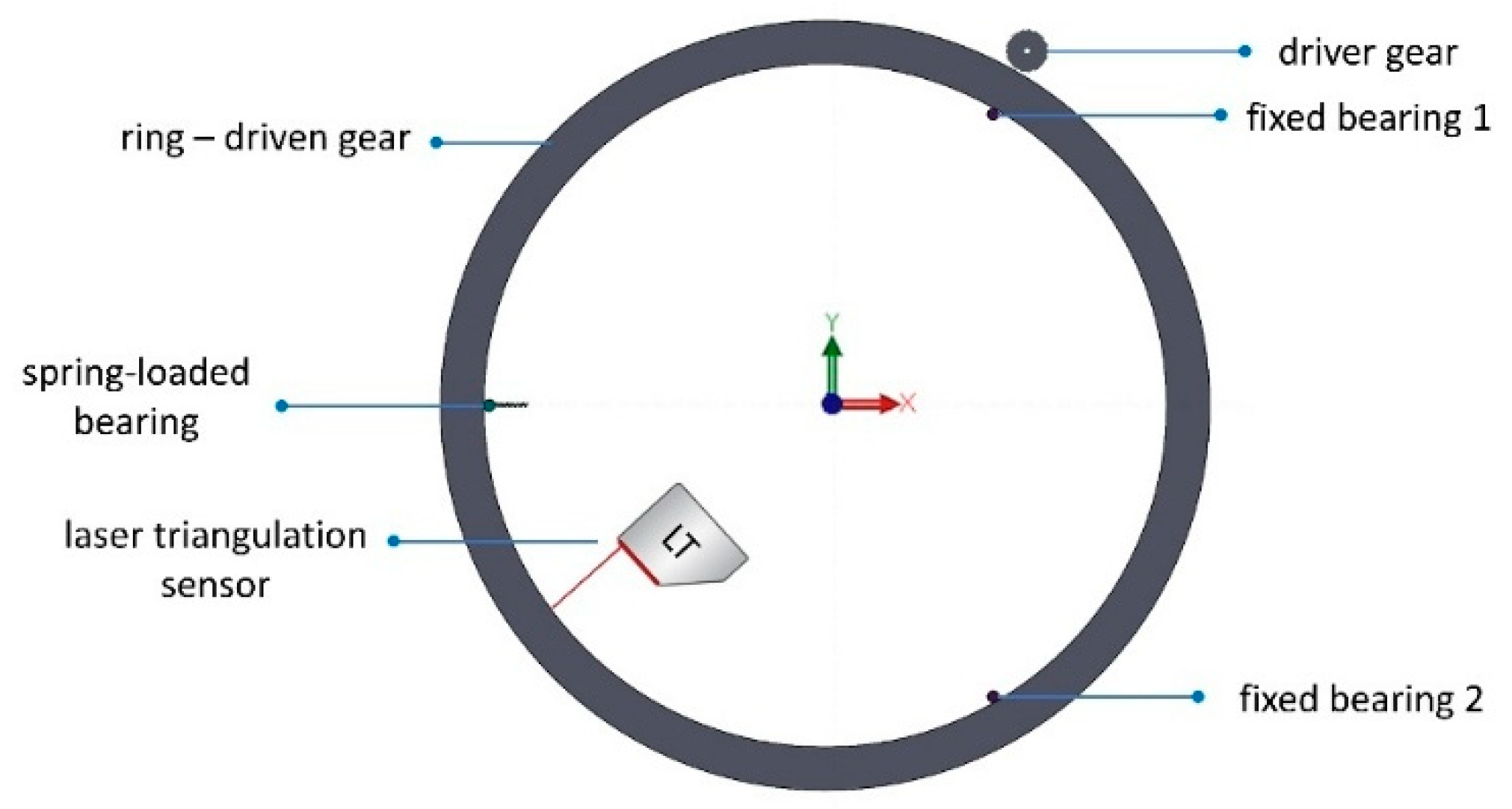
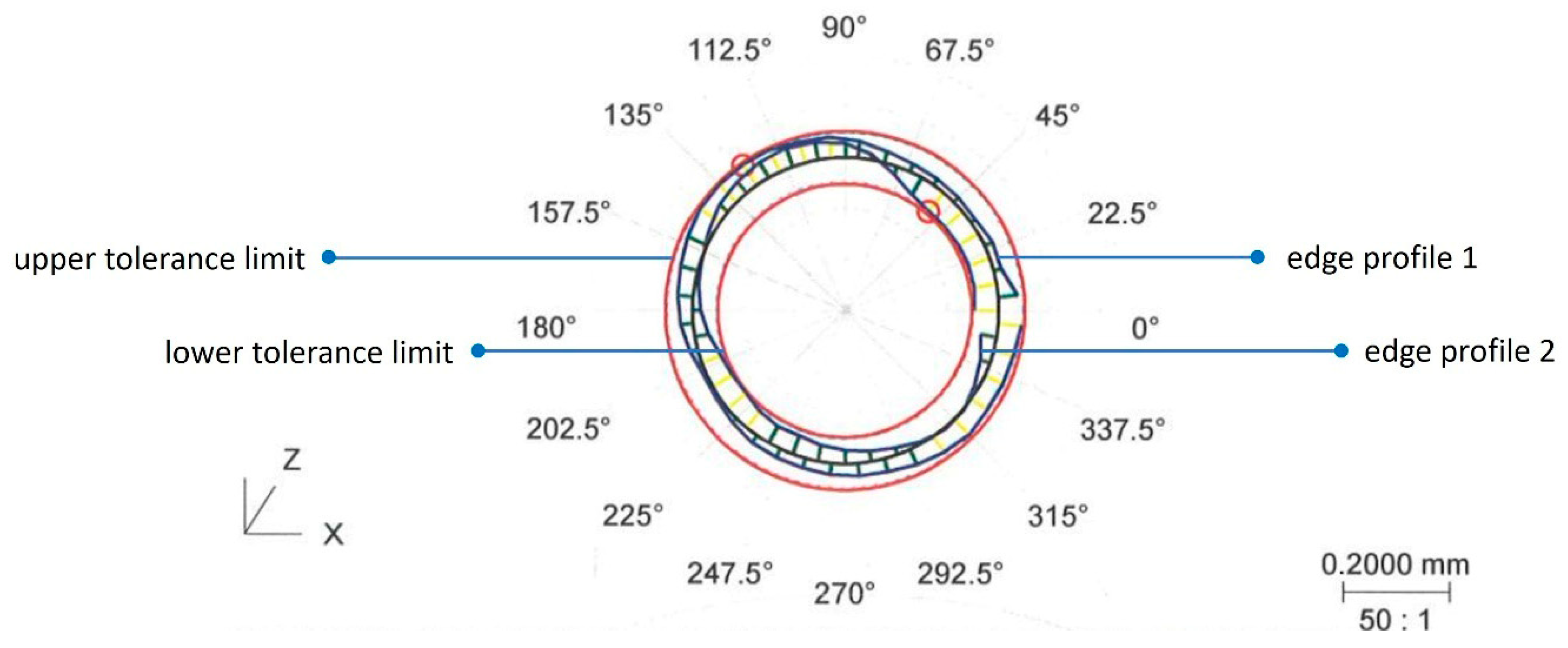
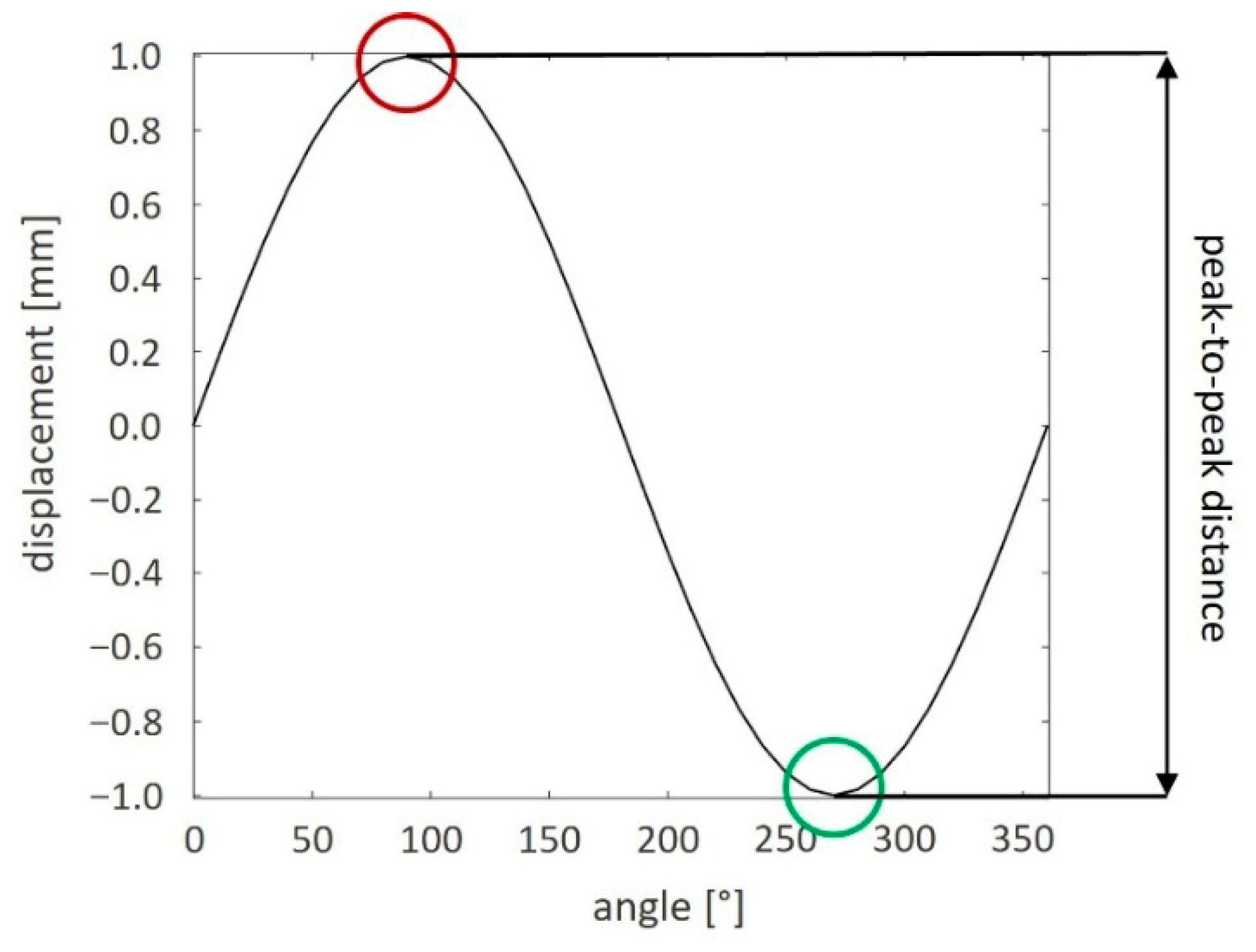

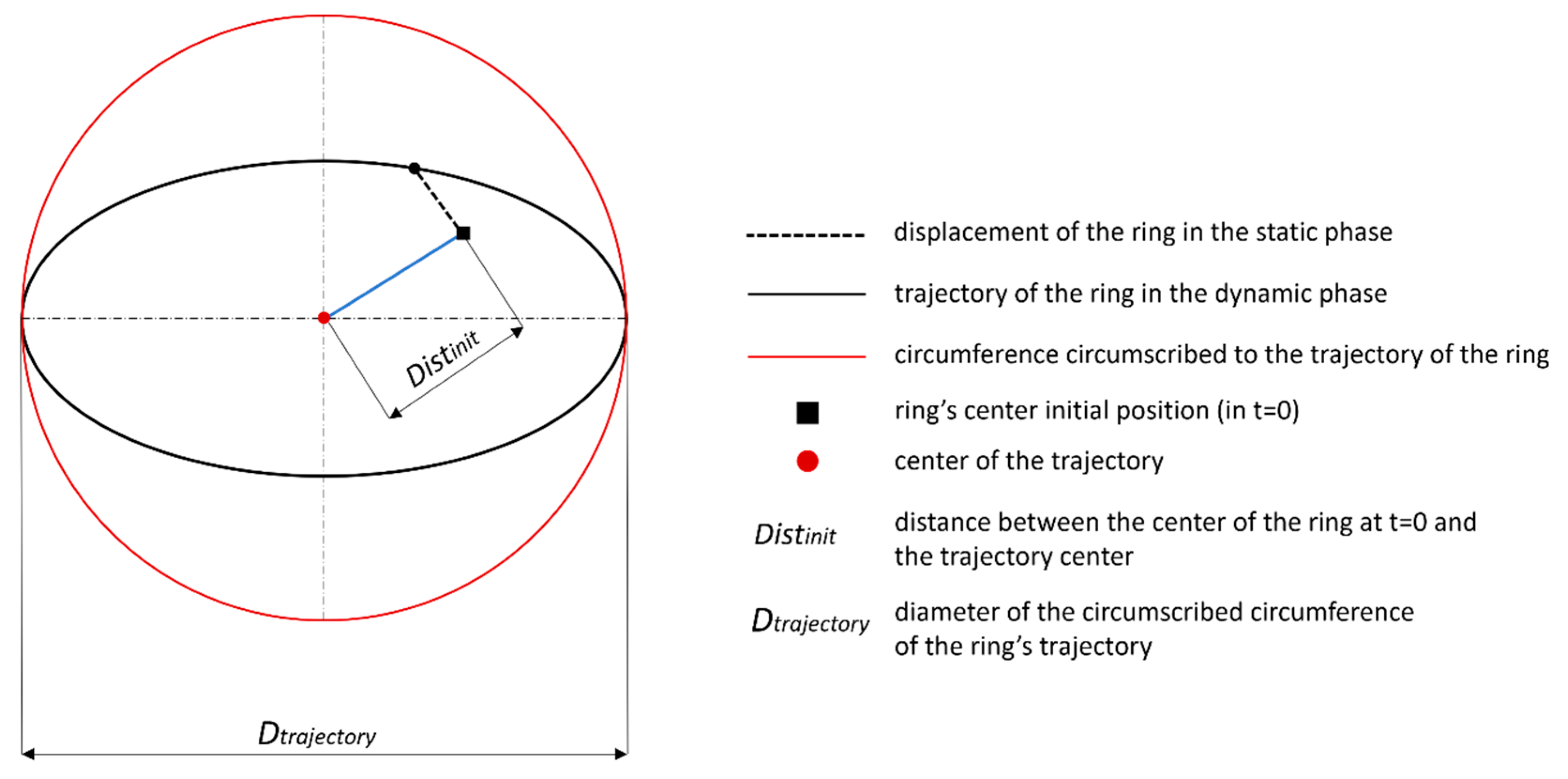
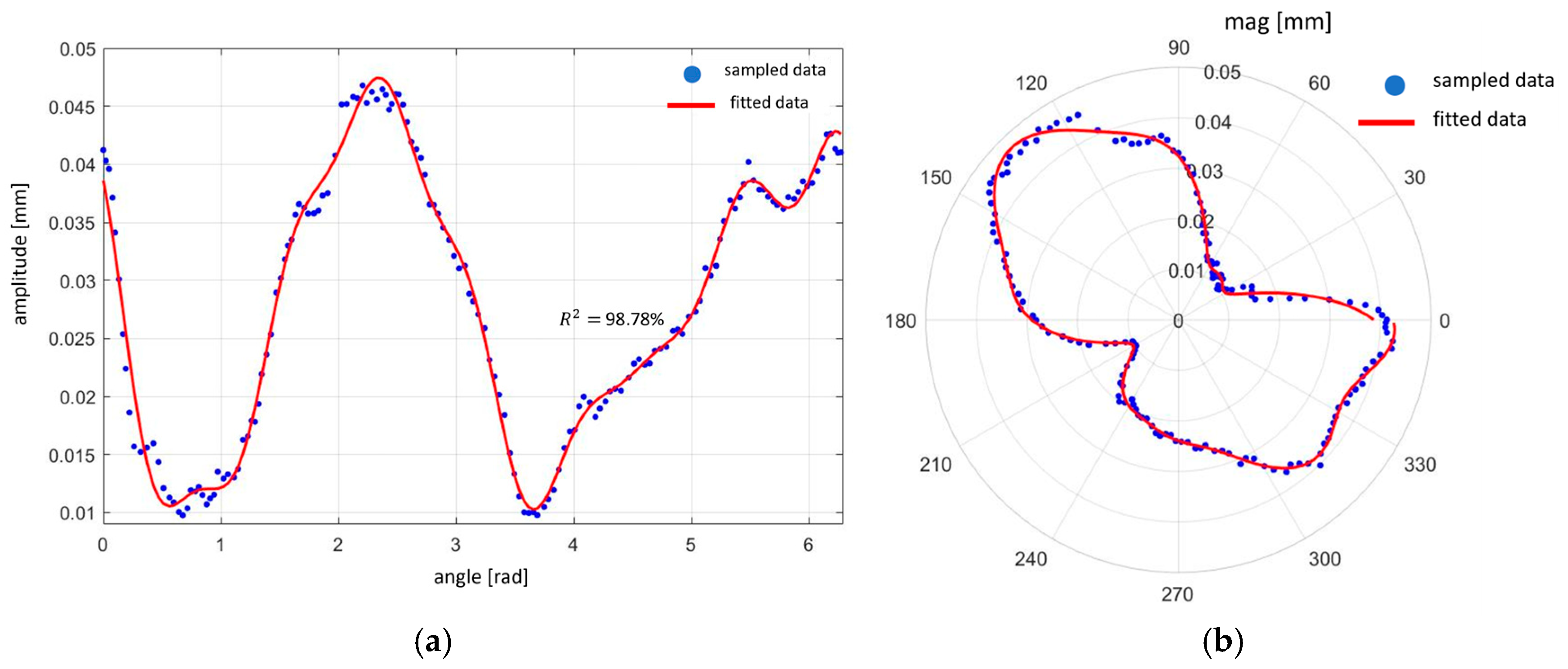

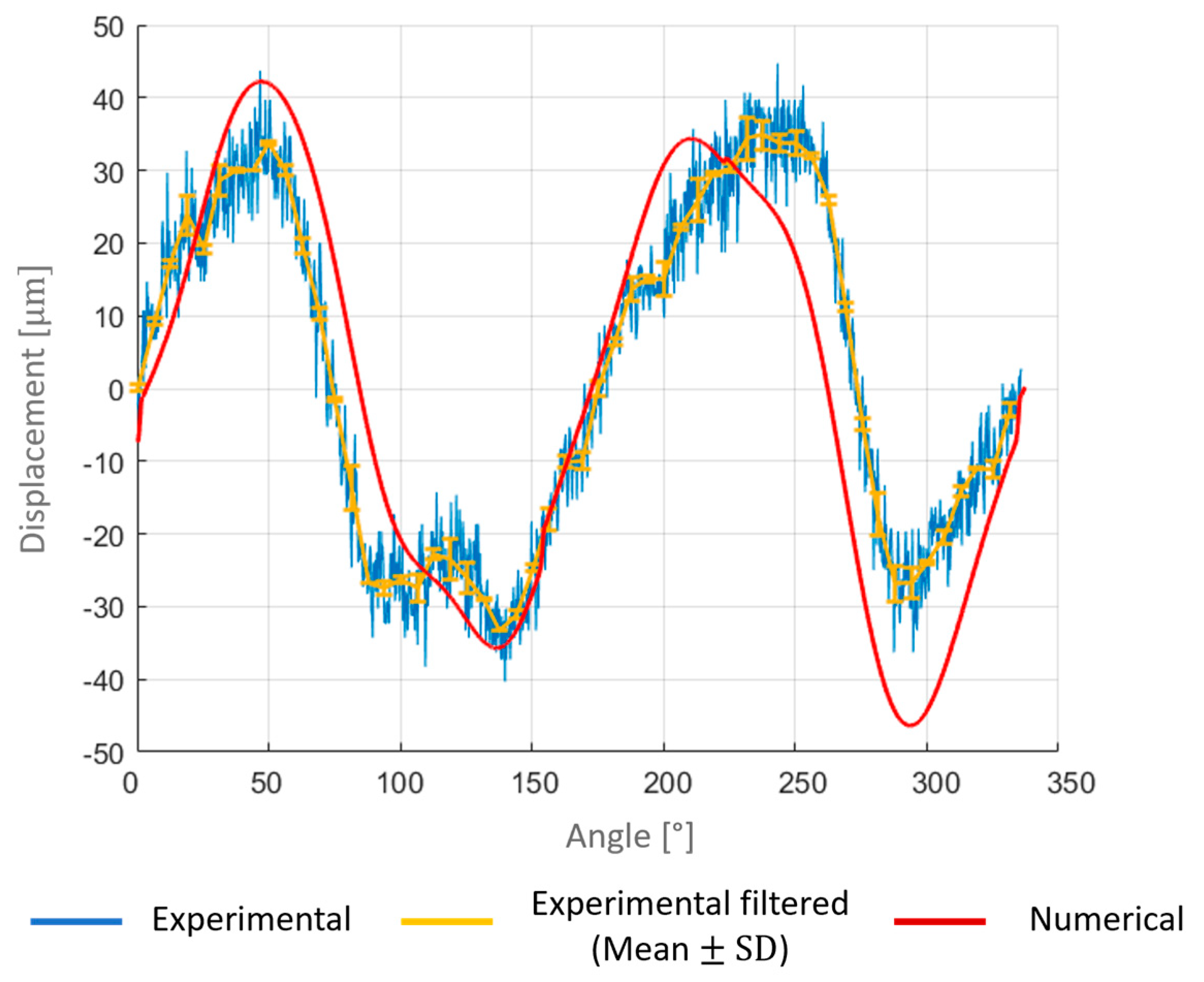
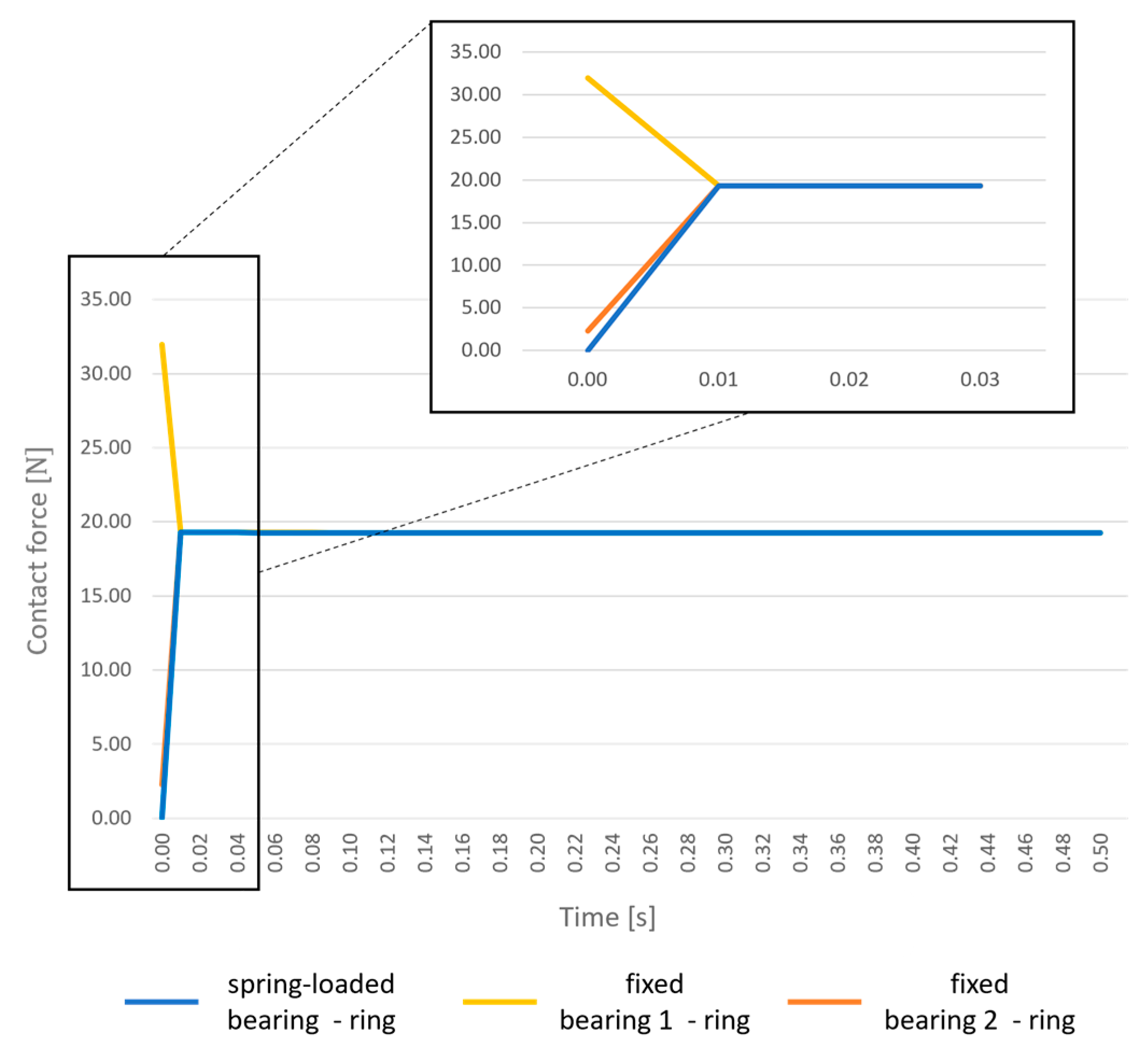
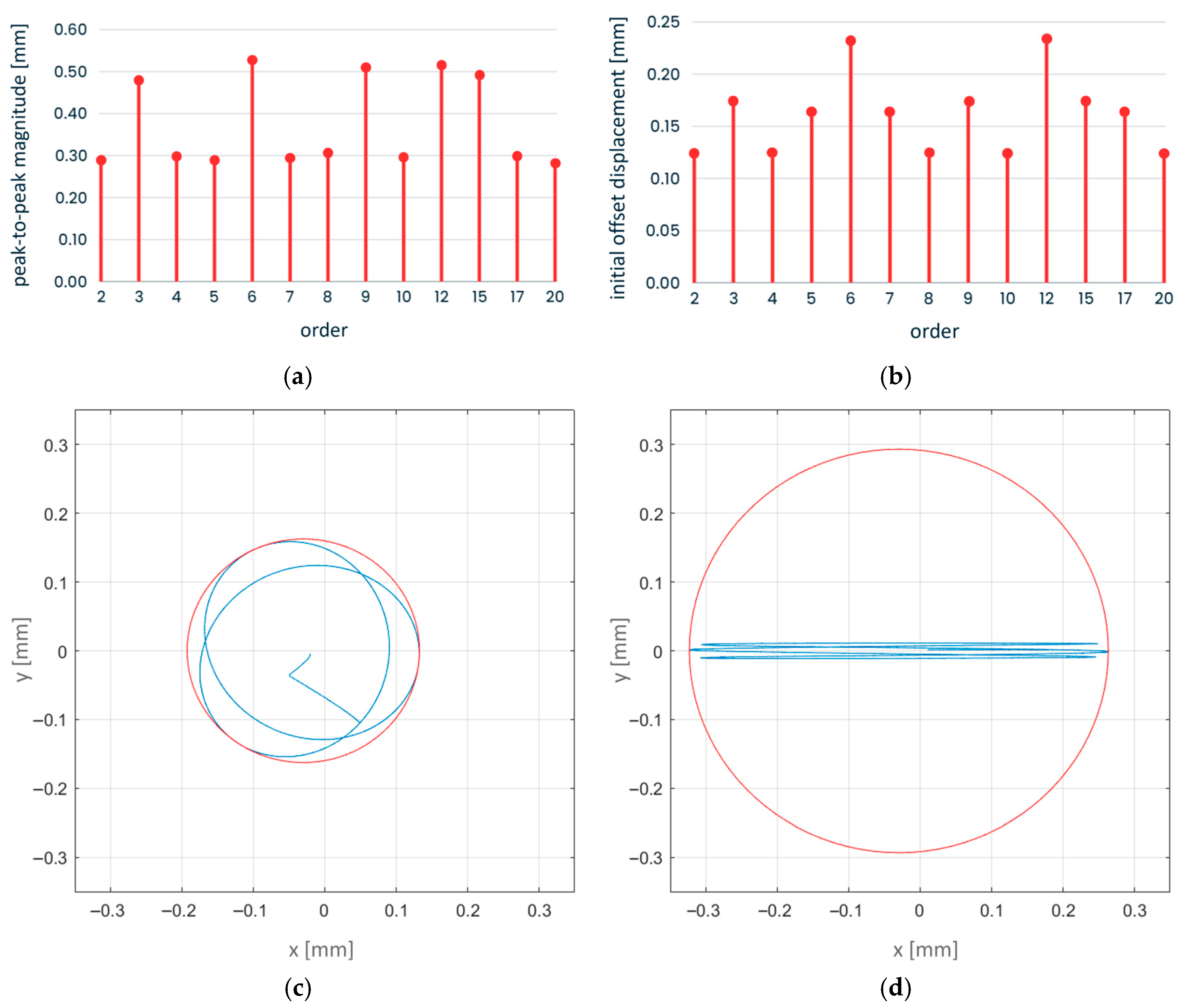
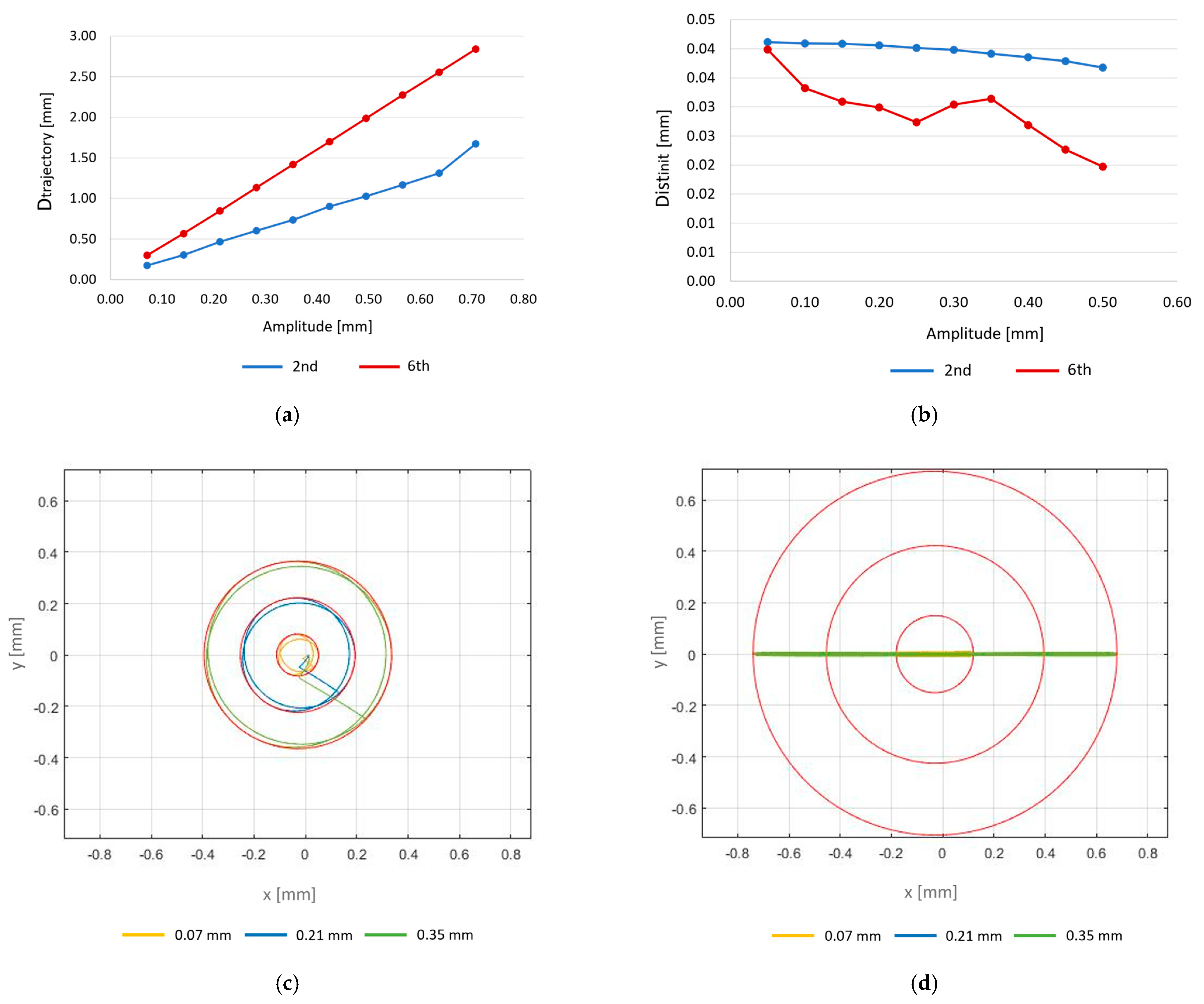
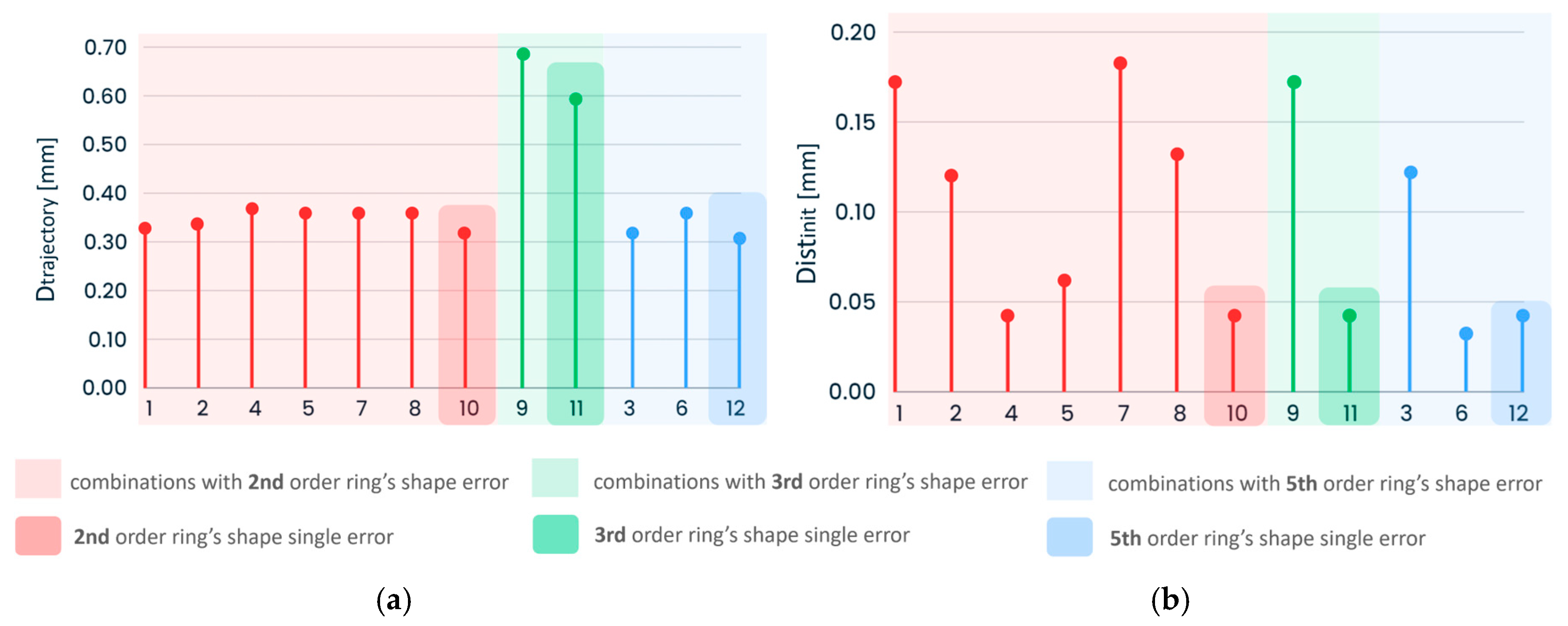
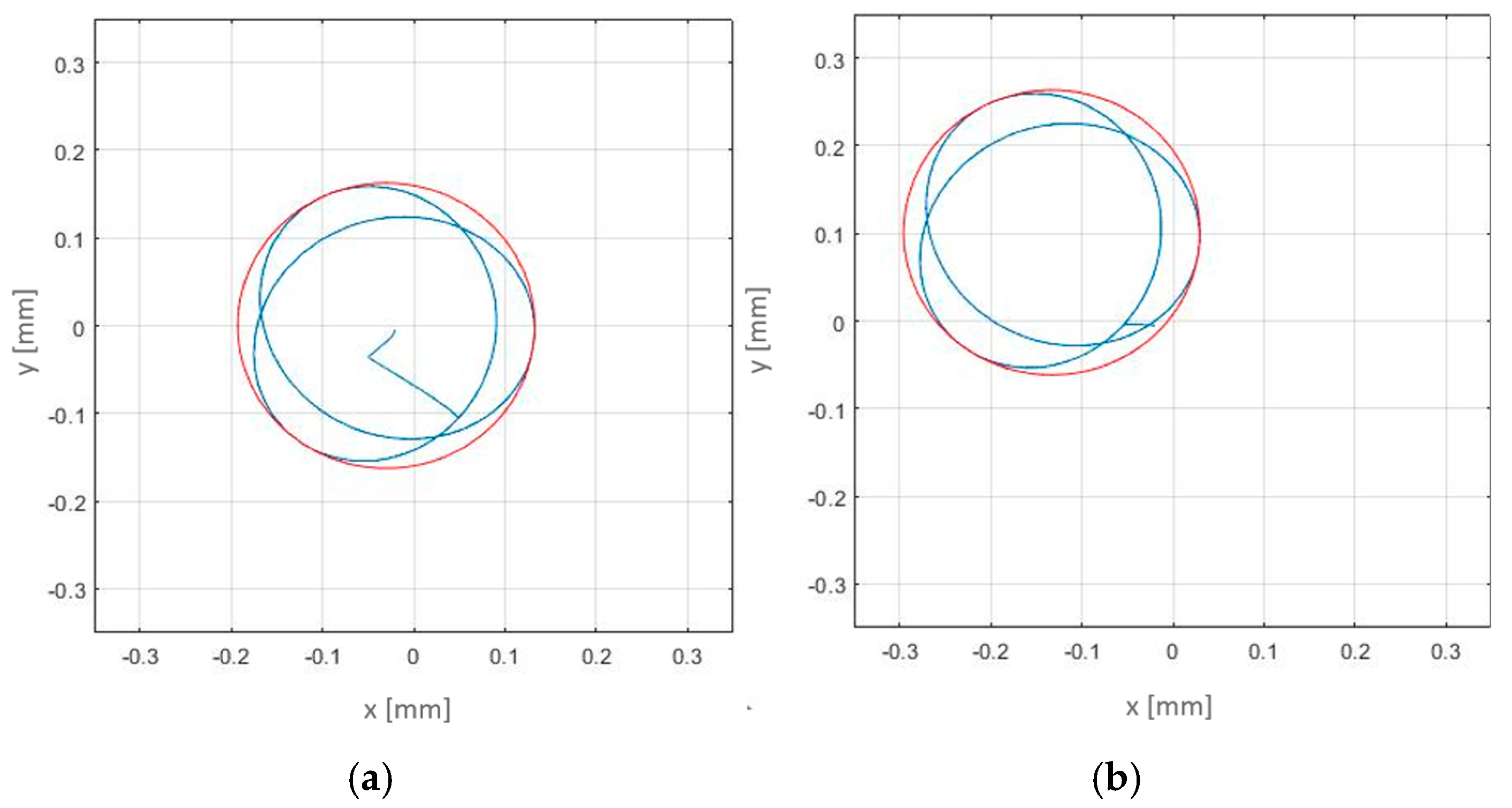
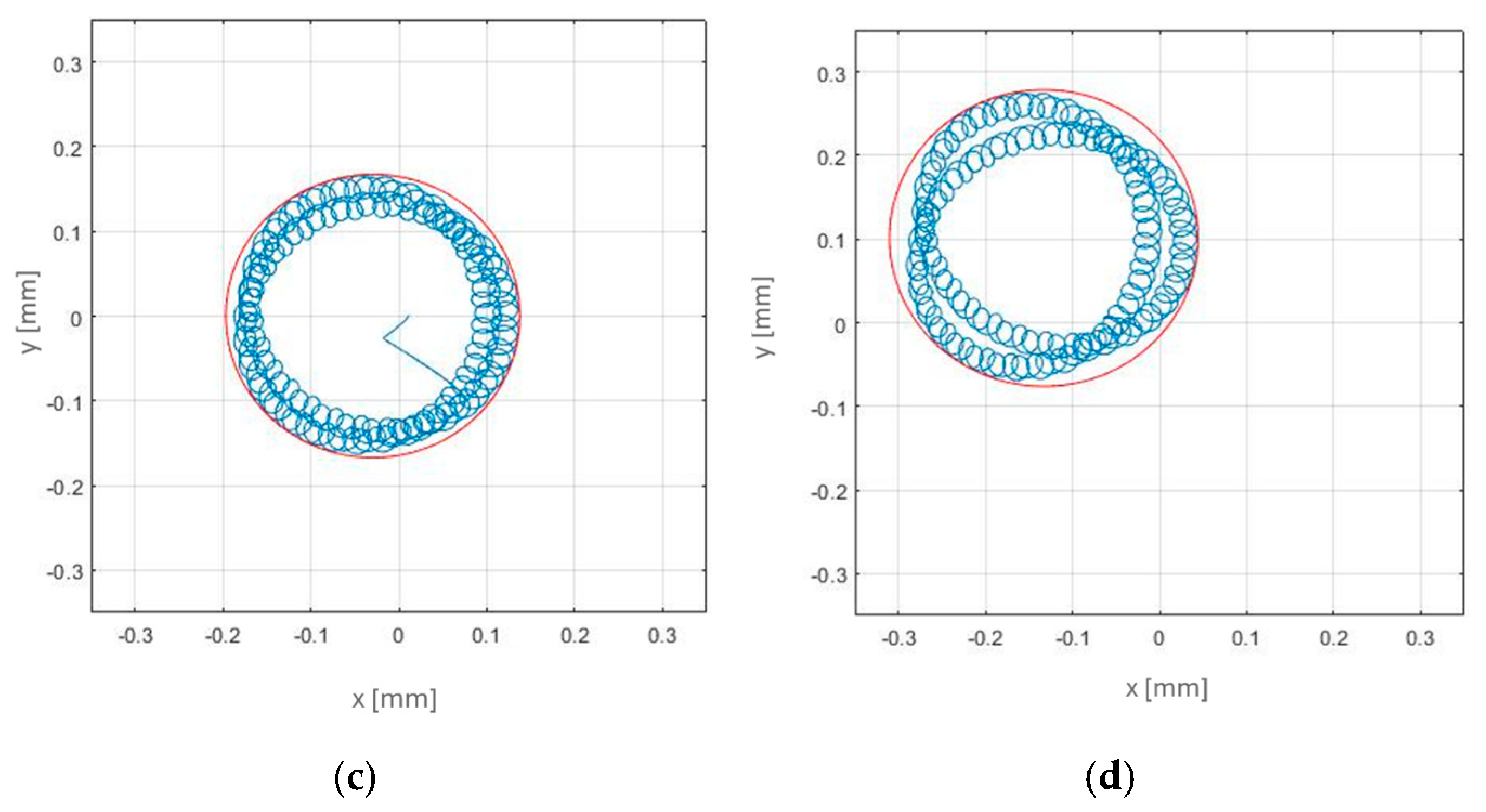
| Laser Triangulator | Bearings | Spring | |||
|---|---|---|---|---|---|
| Parameter | Value | Parameter | Value | Parameter | Value |
| Resolution | 0.3 μm | External diameter | 10 mm | Stiffness (kb) | 1334 N/m |
| Light spot diameter | <0.25 mm | Internal diameter | 4 mm | Preload (F) | 19.3 N |
| Working range | 20–40 mm | Height | 4 mm | ||
| Linearity deviation | 10 μm | ||||
| Switching frequency | 15 kHz | ||||
| Response time | <33 μs | ||||
| Parameter | Value |
|---|---|
| Dout | 679.7 mm |
| Din | 604.0 mm |
| Db | 10.0 mm |
| DOF | Fixed Bearings | Spring-Loaded Bearing | Ring |
|---|---|---|---|
| x | 0 | free | free |
| y | 0 | 0 | free |
| z | 0 | 0 | 0 |
| Rx | 0 | 0 | free |
| Ry | 0 | 0 | free |
| Rz | free | free | 270°/s |
| Parameter | Value |
|---|---|
| e | 1.5 |
| k | 1.0 × 107 N/me |
| cmax | 1.0 × 105 N·s/m |
| d | 0.001 mm |
| μs | 0.61 |
| μd | 0.47 |
| vs | 10 mm/s |
| vd | 50 mm/s |
Disclaimer/Publisher’s Note: The statements, opinions and data contained in all publications are solely those of the individual author(s) and contributor(s) and not of MDPI and/or the editor(s). MDPI and/or the editor(s) disclaim responsibility for any injury to people or property resulting from any ideas, methods, instructions or products referred to in the content. |
© 2025 by the authors. Licensee MDPI, Basel, Switzerland. This article is an open access article distributed under the terms and conditions of the Creative Commons Attribution (CC BY) license (https://creativecommons.org/licenses/by/4.0/).
Share and Cite
Konopada, U.; Pascoletti, G.; Corrado, M.; Zanetti, E.M. Multibody Dynamics for Assessing Tolerance Effects in Roller-Bearing-Supported Rings. Designs 2025, 9, 120. https://doi.org/10.3390/designs9050120
Konopada U, Pascoletti G, Corrado M, Zanetti EM. Multibody Dynamics for Assessing Tolerance Effects in Roller-Bearing-Supported Rings. Designs. 2025; 9(5):120. https://doi.org/10.3390/designs9050120
Chicago/Turabian StyleKonopada, Ulyana, Giulia Pascoletti, Mauro Corrado, and Elisabetta Maria Zanetti. 2025. "Multibody Dynamics for Assessing Tolerance Effects in Roller-Bearing-Supported Rings" Designs 9, no. 5: 120. https://doi.org/10.3390/designs9050120
APA StyleKonopada, U., Pascoletti, G., Corrado, M., & Zanetti, E. M. (2025). Multibody Dynamics for Assessing Tolerance Effects in Roller-Bearing-Supported Rings. Designs, 9(5), 120. https://doi.org/10.3390/designs9050120









